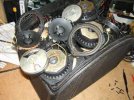My main interference is not pure tones. and they don't fall magically exactly in one FFT bin.That graph showed mains interference which is pure tones.
their noise still be inaudible
noise != pure tones...he GR research B24 is indeed less receptive to AC noise inducement.
The threshold of hearing is at around 0dbSPL so this defines the position of the green line to be at -120dB from the pure tone peak if the peak is per definition 120dbSPL.All I asked for was the reference as it's not on the graph.
But this is an electrical measurement not an acoustical. so the peak has a voltage level not an SPL level
We don't know the test voltage level.
To make the cable look worse just decrease the electrical signal defined as 120dbSPL by 30dBV and you get a 30dB worse SNR
To make the cable look better just increase the electrical signal defined as 120dbSPL by 30dBV and you get a 30dB better SNR

